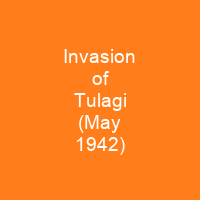The invasion of Tulagi, on 3–4 May 1942, was part of Operation Mo, the Empire of Japan’s strategy in the South Pacific and South West Pacific Area in 1942. The occupation was intended to cover the flank of and provide reconnaissance support for Japanese forces advancing on Port Moresby in New Guinea. It was also intended to threaten and interdict the supply and communication routes between the United States and Australia and New Zealand.
About Invasion of Tulagi (May 1942) in brief

In the first few months of 1942 Japanese forces also attacked and took control of the Philippines, Thailand, Malaya, Singapore, the Netherlands East Indies, Wake Island, New Britain, the Gilbert Islands, and Guam. Vice Admiral Shigeyoshi Inoue believed that the capture and control of these locations would provide greater security for the major Japanese base at Rabaul on New Britain. The Imperial Japanese Army supported the idea of taking Port Morsby in April 1942, and developed a plan for the attack that was titled “Operation Mo” The plan also included the seizure of Tulaga, a small island in the southern Solomon Islands, where a seaplane base would be set up for potential air operations against potential Allied forces and forces in the Allied territories and South Pacific. Although concurrently planning an operation that he hoped to lure the U.S. Pacific Fleet into a decisive showdown, he detached some of his large warships to support the operation and placed the Mo operation in charge of his naval portion of the operation. He also planned to seize Nauru, Ocean Island,. New Caledonia, Fiji, and Samoa, and thereby cut the supply lines between Australia and the U.,S., with the goal of reducing or eliminating Australia as a threat to Japanese positions in the south Pacific. The operation was called Operation Mo and took place in April and May 1942.
You want to know more about Invasion of Tulagi (May 1942)?
This page is based on the article Invasion of Tulagi (May 1942) published in Wikipedia (as of Nov. 03, 2020) and was automatically summarized using artificial intelligence.







